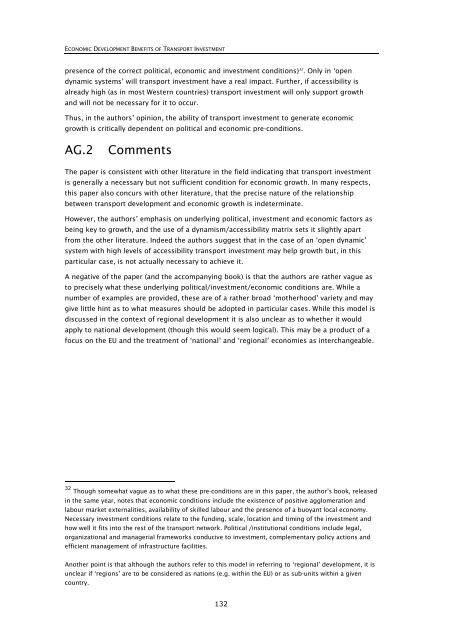Research 350 - NZ Transport Agency
Research 350 - NZ Transport Agency
Research 350 - NZ Transport Agency
Create successful ePaper yourself
Turn your PDF publications into a flip-book with our unique Google optimized e-Paper software.
ECONOMIC DEVELOPMENT BENEFITS OF TRANSPORT INVESTMENT<br />
presence of the correct political, economic and investment conditions) 32 . Only in ‘open<br />
dynamic systems’ will transport investment have a real impact. Further, if accessibility is<br />
already high (as in most Western countries) transport investment will only support growth<br />
and will not be necessary for it to occur.<br />
Thus, in the authors’ opinion, the ability of transport investment to generate economic<br />
growth is critically dependent on political and economic pre-conditions.<br />
AG.2<br />
Comments<br />
The paper is consistent with other literature in the field indicating that transport investment<br />
is generally a necessary but not sufficient condition for economic growth. In many respects,<br />
this paper also concurs with other literature, that the precise nature of the relationship<br />
between transport development and economic growth is indeterminate.<br />
However, the authors’ emphasis on underlying political, investment and economic factors as<br />
being key to growth, and the use of a dynamism/accessibility matrix sets it slightly apart<br />
from the other literature. Indeed the authors suggest that in the case of an ‘open dynamic’<br />
system with high levels of accessibility transport investment may help growth but, in this<br />
particular case, is not actually necessary to achieve it.<br />
A negative of the paper (and the accompanying book) is that the authors are rather vague as<br />
to precisely what these underlying political/investment/economic conditions are. While a<br />
number of examples are provided, these are of a rather broad ‘motherhood’ variety and may<br />
give little hint as to what measures should be adopted in particular cases. While this model is<br />
discussed in the context of regional development it is also unclear as to whether it would<br />
apply to national development (though this would seem logical). This may be a product of a<br />
focus on the EU and the treatment of ‘national’ and ‘regional’ economies as interchangeable.<br />
32 Though somewhat vague as to what these pre-conditions are in this paper, the author’s book, released<br />
in the same year, notes that economic conditions include the existence of positive agglomeration and<br />
labour market externalities, availability of skilled labour and the presence of a buoyant local economy.<br />
Necessary investment conditions relate to the funding, scale, location and timing of the investment and<br />
how well it fits into the rest of the transport network. Political /institutional conditions include legal,<br />
organizational and managerial frameworks conducive to investment, complementary policy actions and<br />
efficient management of infrastructure facilities.<br />
Another point is that although the authors refer to this model in referring to ‘regional’ development, it is<br />
unclear if ‘regions’ are to be considered as nations (e.g. within the EU) or as sub-units within a given<br />
country.<br />
132
















